LinkedIn! It’s a huge part of my process for landing clients, and it’s a big part of what I teach my students in Revenue Spark.
Maintaining an active profile and focusing on improving engagement can really boost your visibility on the platform, and make it significantly easier to connect with people you might want to work with.
One way to improve your engagement is to use hashtags in your posts.
So let’s talk a little bit about how the feature works, and how you can best utilize it.
Is video more your jam? Here you go!
How Do Hashtags Work on LinkedIn?
Hashtags on LinkedIn operate very similarly to other platforms. LinkedIn uses hashtags to catalogue and organize the content that uses those hashtags.
For an example, if you search #freelancewriting, you can go to the main page for the hashtag #freelancewriting.
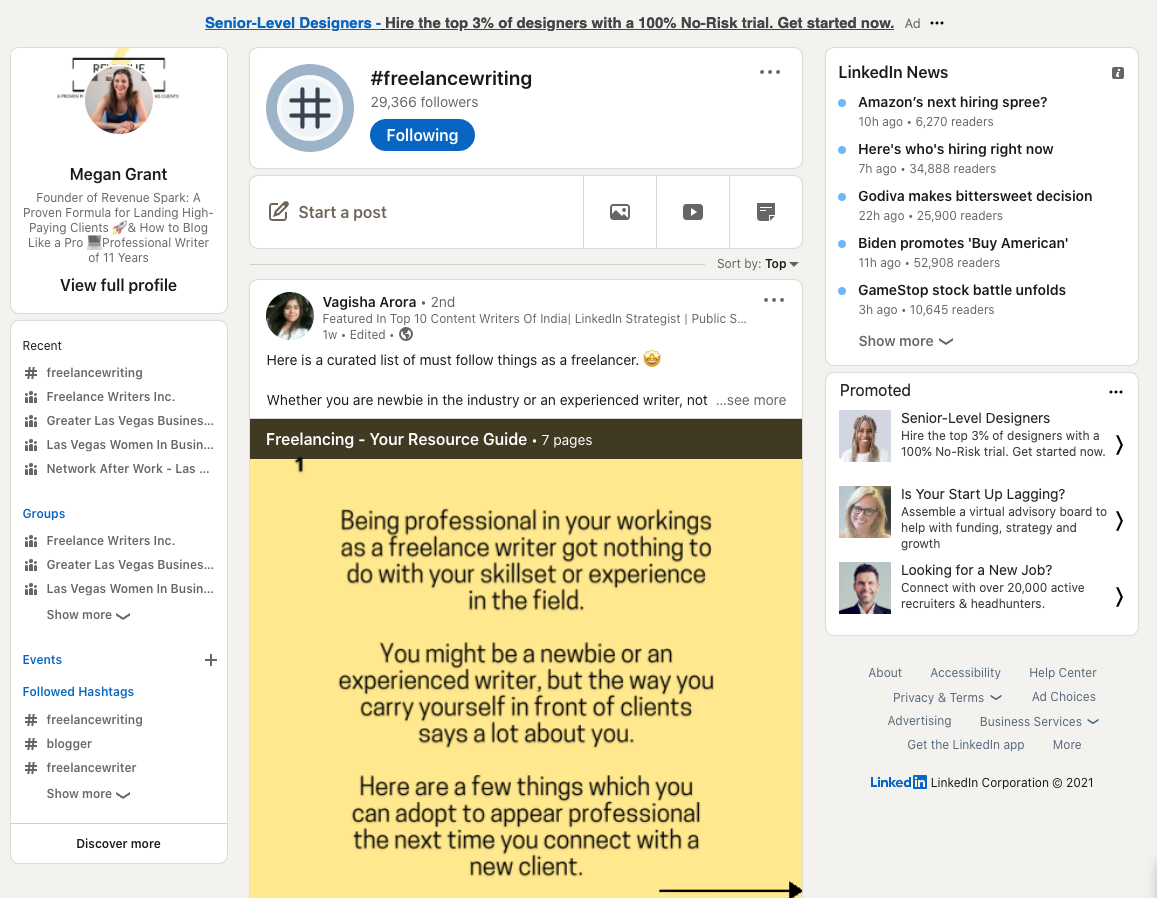
The number under the hashtag reflects how many people are following this hashtag, and if we scroll down this page, LinkedIn will show us all of the posts people have shared using this hashtag.
It’s good to check these out because it’ll give you an idea of what other people are talking about, and it’ll give you inspiration for posts you’ll share in the future.
If it’s a hashtag that’s relevant to you and your business, follow it!
If you ever want to see all of the hashtags you’re currently following, scroll down and click where it says “Followed Hashtags.”
It also makes it pretty easy to unfollow any hashtags that you’re no longer interested in.
That’s a very quick tour of hashtags. Now let’s move more into how you can use them to maximize your own exposure and engagement.
How to Use Hashtags Strategically
First, let’s get this out of the way. Hashtags aren’t just for vanity. They’re not an accessory. They’re a tool. So you need to use them strategically.
I know that on a platform like Instagram, where a lot of us are just using it for fun, for our personal lives, sometimes we’ll use hashtags just to be silly. Like when I use the hashtags #MyChihuahuaCouldBeatUpYourHonorRollStudent, I don’t expect that to actually bring me traffic.
With LinkedIn, stay away from this.
Your hashtags should be professional and relevant to what the post is about. Remember, you’re going to show up on the page for that hashtag, so it needs to make sense, in terms of the content you’re sharing in that post.
Now, let’s dive a little more into how to find a good hashtag.
First, you want to keep in mind that the hashtags you use should be relevant to that specific post, and not necessarily to your profile as a whole.
Let’s say I’m sharing a post with tips for becoming an entrepreneur. It’s not unreasonable to want to use the hashtag #entrepreneurship in my post. But let’s look at this a little more closely. If we search this hashtag, take a look at the number. Again, this is how many people are currently following this hashtag. This is important.
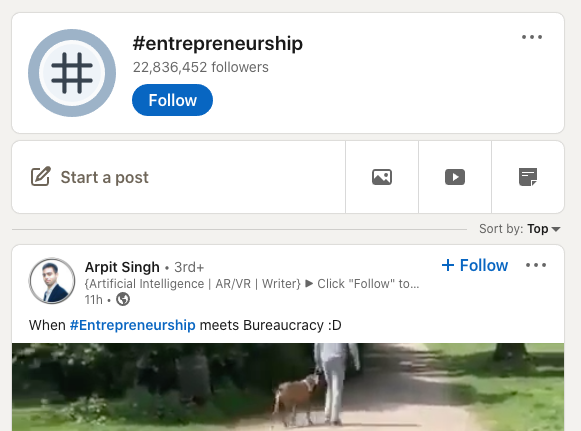
You might see this number and think, “The bigger the better.” But that’s not necessarily the case. The more popular a hashtag is, the more competitive it is, and the more content there is using it. This means it’s going to be harder to gain visibility.
Now does that mean you shouldn’t use it? No. But it does mean that you’ll probably want to use it along with another hashtag that’s more specific, with a smaller following. You might notice that when we start searching this hashtag, LinkedIn shows us similar results. It’s giving us related hashtags, so what we can do is go through these and look for one with a smaller audience.
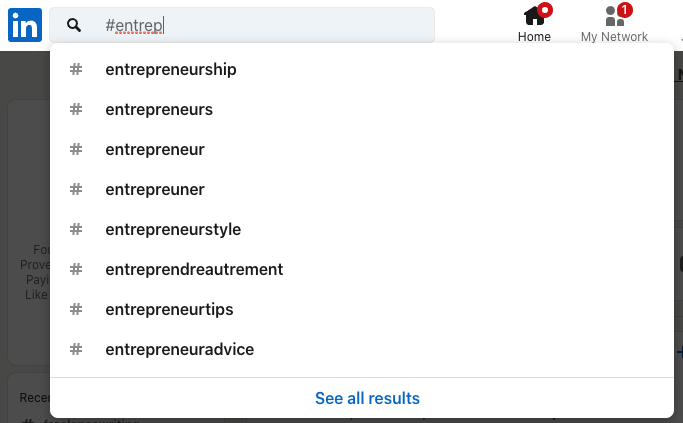
Let’s try #entrepreneur. This one has fewer people following it, and honestly, we could stand to go even smaller. The smaller you go, the likelier it is that you’ll be found on that hashtag’s page.
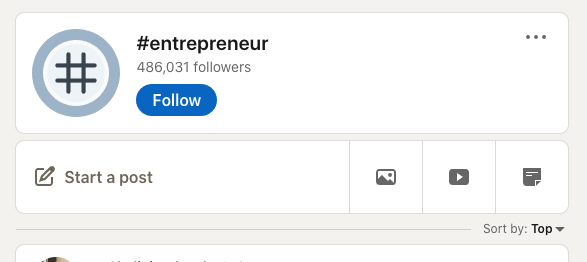
Another way to get hashtag ideas, aside from LinkedIn’s autocomplete, is to add one hashtag after drafting your post, and you’ll see that LinkedIn will start making suggestions. Here’s an example.
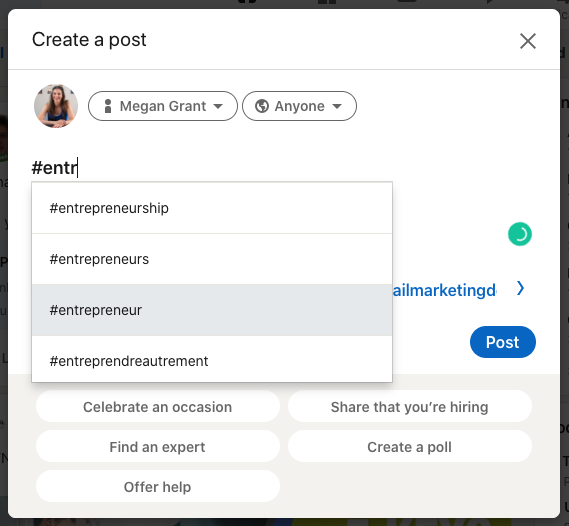
I’ll typically use 3-5 hashtags in a post, and I use a variety of tags with a small, medium, and large following. This way, you’re kind of getting the best of every world.
Do not pack in as many hashtags as LinkedIn will allow. It looks spammy and unprofessional, and it’s bad for user experience.
Bear in mind that when LinkedIn tells you how many people are following a hashtag, that doesn’t mean that that many people will see your post. So let’s say the hashtag you use has 100,000 followers. Will 100,000 people see your post with that hashtag?
No.
There are still a lot of variables at play here. For example, when you post something, LinkedIn is watching to see how much engagement it gets. It wants to determine if people care about that post. If your post gets a lot of engagement — likes, comments, and shares — LinkedIn goes, “Oh ok, people like this.” And it will show it to more people, and more of the type of people you’re looking to reach.
This means that to help your hashtags perform better, it’s in your best interest to encourage as much engagement on your posts as possible. There are a lot of ways to do this, but one that’s extremely effective is either tagging people in the post itself, or tagging them in a comment.
Only tag people when it makes sense. Do NOT spam people. Instead, choose a few people who you think would be particularly interested in seeing that post. And invite them to join the conversation.
One of my students in Revenue Spark, Johan, is really good about this.
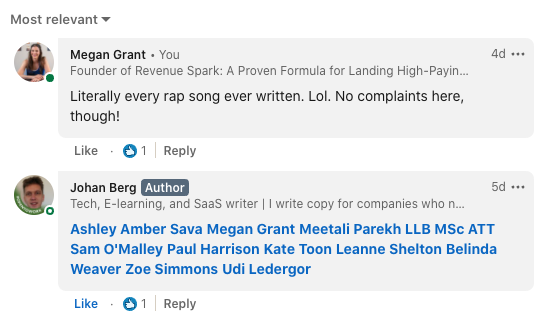
He’ll tag me and a few others in a comment. I always get the notification, and I’ll go to that post, and it’s always something I’m interested in, because he would never tag me otherwise, and I comment.
This boosts the engagement rate of his posts, which offers a number of benefits, including hashtags that will work even more in his favor.
Engagement helps hashtags. Hashtags help engagement. Round and round we go.
Using Branded Hashtags on LinkedIn
Next I want to talk about branded hashtags.
Branded hashtags are hyper-specific tags that directly reflect you, or your company, or a product/service you sell.
For example, if I mention my program, Revenue Spark, in a post, I’ll use the hashtag, #RevenueSpark.
It’s not because I’m expecting it to bring me a ton of traffic. It won’t. But remember what I said earlier: LinkedIn uses hashtags to catalogue all of the content shared using that tag.
So if I’m using the hashtag #RevenueSpark when it’s applicable, if someone visits the page for that hashtag, they’re going to see all of my content, and only my content. It’s like my own personal little page all about my course.
You can use this to your advantage by telling your connections, “Hey, go check out this page to learn more about my course.”
I’ve also used branded hashtags for my name, so #MeganGrant, and my other offers, like #The7DaySecret and #HowToBlogLikeAPro, two of my other courses.
When you’re picking out a branded hashtag, search it first to make sure it’s not already something that’s commonly used. If people are using it here and there, that’s okay. But we want to stay away from anything that’s already pretty popular, because it kind of defeats the purpose.
Also, be sure you’re using it consistently, again, when it’s applicable. You really want to build up the content for that hashtag’s page.
Hashtags are an amazing tool that people generally don’t utilize enough. Spend just a few minutes on this, and you will see your post engagement go up. Don’t just barf up whatever random hashtags you think of, though. Look at their audiences. See what kinds of followings they have. Include a little variety. And make sure they’re relevant to the content you’re sharing.
I mentioned in the beginning that I use LinkedIn on a daily basis to connect with leads and land new clients for my business. If you want to learn a little more about that, check out my mini-course, The 7-Day Secret . I built it to be quickly consumed and easily digested, and still help you make progress with your client acquisition in one week.
Yes, this is a paid mini-course. It’s $37. 😉